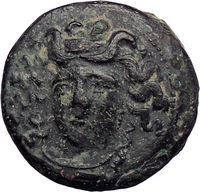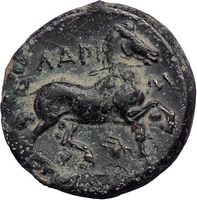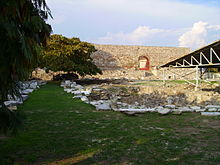Larissa Ancient Greek City in Thessaly Northern Greece Authentic Coins
Buy certified ancient coins with
Larissa Ancient Greek City
Every item purchased here comes with a beautiuful custom-made
certificate of authenticity, complete with professional description,
research, professional photograph and historical synopsis, a $50-$100
value, absolutely free, signed by world-renowned ancient coin expert,
Ilya Zlobin.
 
Authentic Ancient Coin of:
Greek city of Larissa in Thessaly under Macedonian
domination
Bronze 19mm (8.80 grams) Struck 350-325 B.C.
Reference: Sear 2131
Head of nymph Larissa three-quarter face to left, wearing necklace; hair
confined b fillet and floating loosely, with ampyx in front.
ΛΑΡΙΣΑIΩΝ - Horse trotting right, ear of corn beneath.
Larissa (Greek: Λάρισα, [ˈlarisa])
is the capital and biggest city of the Thessaly region of Greece and
capital of the Larissa regional
unit. It is a principal agricultural centre and a national
transportation hub, linked by road and rail with the port of Volos,
the city of Thessaloniki and Athens.
Larissa, within its municipality, has 162,591 inhabitants, while the
regional unit of Larissa reached a population of 284,325 (in 2011). The
urban area of the city, although mostly contained within the Larissa
municipality, also includes the communities of Giannouli, Platykampos, Nikaia,
Terpsithea and several other suburban settlements, bringing the wider
urban area population of the city to about 220,000 inhabitants. Today,
Larissa is a major commercial and industrial centre in Greece.
Legend has it that Achilles was
born here, and that Hippocrates,
the Father of Medicine, died here.
Geography
There are a number of highways including E75 and
the main railway from Athens to Thessaloniki (Salonika)
crossing through Thessaly.
The region is directly linked to the rest of Europe through
the International
Airport of Central Greecelocated in Nea
Anchialos a short
distance from Larissa. Larissa lies on the river Pineios.
The Larissa
Chasma, a deep gash in the surface of Dione,
a natural satellite of Saturn, was named after Larissa.
Climate
The climate of Larissa is transitional. The winter is very cold and wet,
and some snowstorms may occur. The summer is warm, and temperatures of 40
°C (104 °F) are
usual and there is 15 times that maximum temperature exceeded 43.4
°C(110.1 °F) in the
period 1955-2012. Thunderstorms
or heavy rain may cause agricultural damage. The highest recorded
temperature is 45.4
°C (113.7 °F) (July
2000) and the lowest recorded temperature is −21.6
°C (−6.9 °F)(January
1968). Larissa receives only 450 mm (18 in) of rain per year while
Corfu, for example, receives 1,080 mm (43 in) of rain per year, because
the mountais of Pindos create a rainshadow for the eastern coast of
Greece.
Mythology
According to Greek
mythology it is said that
the city was founded by Acrisius,
who was killed accidentally by his grandson, Perseus. There
lived Peleus,
the hero beloved by the gods, and his son Achilles.
In mythology, the nymph Larissa was
a daughter of the primordial man Pelasgus.
The city of Larissa is mentioned in Book II of Iliad by Homer:
Hippothous led the tribes of Pelasgian spearsmen, who dwelt in
fertile Larissa-
Hippothous,and Pylaeus of the race of Mars, two
sons of the Pelasgian Lethus, son of Teutamus. http://classics.mit.edu/Homer/iliad.2.ii.html
In this paragraph, Homer shows that the Pelasgians,
Trojan allies, used to live in the city of Larissa. It is contradictory
because Larissa was also the birthplace of Achilles,
the sworn enemy of Trojans.
History
Antiquity
Traces of Paleolithic human
settlement have been recovered from the area, but it was peripheral to
areas of advanced culture. The
area around Larissa was extremely fruitful; it was agriculturally
important and in antiquity was
known for its horses.
The name Larissa (Λάρισα Lárīsa)
is in origin a Pelasgian (pre-Greek)
word for "fortress". There were many ancient Greek cities with this
name.[8] The
name of Thessalian Larissa is first recorded in connection with the
aristocratic Aleuadai family.
Larissa is thought to be where the famous Greek physician Hippocrates and
the famous philosopher Gorgias
of Leontini died.
When Larissa ceased minting the federal coins it shared with other
Thessalian towns and adopted its own coinage in the late 5th century BC,
it chose local types for its coins. The obverse depicted the nymph of
the local spring, Larissa, for whom the town was named; probably the
choice was inspired by the famous coins of Kimon depicting
the Syracusan nymph Arethusa.
The reverse depicted a horse in various poses. The horse was an
appropriate symbol of Thessaly, a land of plains, which was well known
for its horses. Usually there is a male figure; he should perhaps be
seen as the eponymous hero of the Thessalians, Thessalos, who is
probably also to be identified on many of the earlier, federal coins of
Thessaly.

The ancient theatre of the city.
Larissa, sometimes written Larisa on ancient coins and inscriptions, is
near the site of the Homeric Argissa. It appears in early times, when Thessaly was
mainly governed by a few aristocratic families, as an important city
under the rule of the Aleuadae,
whose authority extended over the whole district of Pelasgiotis.
This powerful family possessed for many generations before 369 BC the
privilege of furnishing the tagus,
the local term for thestrategos of
the combined Thessalian forces. The principal rivals of the Aleuadae
were the Scopadac of Crannon,
the remains of which are about 14 miles south west.
Larissa was indeed the birthplace of Meno,
who thus became, along with Xenophon and
a few others, one of the generals leading several thousands Greeks from
various places, in the ill-fated expedition of 401 (retold in Xenophon's Anabasis)
meant to help Cyrus
the Younger, son of Darius
II, king of Persia,
overthrow his elder brother Artaxerxes
II and take over the
throne of Persia (Meno is featured in Plato's
dialogue bearing his name, in which Socrates uses
the example of "the way to
Larissa" to help explain
Meno the difference between true opinion and science (Meno,
97a–c) ; this "way to Larissa" might well be on the part of Socrates an
attempt to call to Meno's mind a "way home", understood as the way
toward one's true and "eternal" home reached only at death, that each
man is supposed to seek in his life).[10]
The constitution of the town was democratic,
which explains why it sided with Athens in
the Peloponnesian
War. In the neighbourhood of Larissa was celebrated a festival which
recalled the Roman Saturnalia,
and at which the slaves were waited on by their masters. It was taken by
the Thebans and
afterwards by the Macedonian kings, and Demetrius
Poliorcestes gained
possession of it for a time, 302 BC.
Hellenistic and
Roman era
It was in Larissa that Philip
V of Macedon signed in
197 BC a treaty with the Romans after his defeat at Cynoscephalae,
and it was there also that Antiochus
III, the Great, won a great victory, 192 BC.
As the chief city of ancient Thessaly, Larissa was directly annexed by
Philip II of Macedon in 344, and from then on Larissa was under
Macedonian control; in 196 B.C. Larissa became an ally of Rome and was
the headquarters of the Thessalian
League.
Larissa is frequently mentioned in connection with the Roman civil wars
which preceded the establishment of the empire and Pompey sought
refuge there after the defeat of Pharsalus.

Inside the medieval fortress.
Middle
Ages and Ottoman period

Gravure from Larissa c.1820.
The town was taken from the Byzantine Empire by Bulgaria for a while in
the later 10th century and later held by Serbia. It was Frankish until
1400.
It was conquered by the Ottoman
Empire in 1386/87 and
again in the 1390s, but only came under permanent Ottoman control in
1423, by Turahan
Bey. Under Ottoman rule,
the city was known as Yeni-şehir
i-Fenari, "new citadel". As the chief town and military base of Ottoman
Thessaly, Larissa was a predominantly Muslim city. The
town was noted for its trade fair in the 17th and 18th centuries, while
the seat of the pasha of Thessaly was also transferred there in 1770. The
city remained in Ottoman hands until Thessaly became part of the
independent Greek kingdom in 1881, except for a period where Ottoman
forces re-occupied it during the Greco-Turkish
War of 1897.
On 6 March 1770, Aya
Pasha massacred there
3000 Christians from Trikala.
In the 19th century, there was a small village in the outskirts of town
very unusually inhabited by Africans from the Sudan,
a curious remnant of the forces collected by Ali
Pasha. In the 19th century, the town produced leather, cotton, silk and tobacco.
Fevers and agues were prevalent owing to bad drainage and the
overflowing of the river; and the death-rate was higher than the birth
rate. It was also renowned
for the minarets of
its mosques (four
of which were still in use in the early part of the 20th century) and
the Muslim burial
grounds.
Modern Greek era

The Municipal Gallery of Larissa.
Larissa was the headquarters of Hursid
Pasha during the Greek
War of Independence. In 1881, the city, along with the rest of Thessaly,
was incorporated into the Kingdom
of Greece. A considerable portion of the Turkish population
emigrated into the Ottoman Empire at that point. During the Greco-Turkish
War of 1897, the city was the headquarters of Greek Crown Prince Constantine.
The flight of the Greek army from here to Farsala took
place on April 23, 1897. Turkish troops entered the city two days later.
After a treaty for peace was signed, they withdrew and Larissa remained
permanently in Greece.
This was followed by a further exodus of Turks in 1898.
Ecclesiastical
history
Christianity penetrated early to Larissa, though its first bishop is
recorded only in 325 at the Council
of Nicaea. St.
Achillius of the 4th
century, is celebrated for his miracles. Lequien cites
twenty-nine bishops from the fourth to the 18th centuries; the most
famous is Jermias II, who occupied the Patriarch
of the West until 733,
when the Emperor Leo
III the Isaurian annexed
it to the Patriarchate
of Constantinople. In the first years of the 10th century it had ten
suffragan sees; subsequently
the number increased and about the year 1175 under the Emperor Manuel
I Comnenus, it reached twenty-eight. At
the close of the 15th century, under the Turkish domination, there were
only ten suffragan sees, which
gradually grew less and finally disappeared.
Larissa remains a titular
see of the Roman Catholic
Church.
Administration
The municipality Larissa was formed at the 2011 local government reform
by the merger of the following 3 former municipalities, that became
municipal units:
Districts
The municipal unit of Larissa is divided into four city-districts or
municipal communities (29 city areas) plus 2 suburban communities (Amphithea
and Koulourion). The Municipality includes also the Community of
Terpsithča (with the suburban community of Argyssa).
1st
Mucicipal District (pop. 26,035)
- Papastŕvrou
- Saint Athanŕsios
- Alkazŕr
- Hippocrates-Pčra
- Potamňpolis
- Philippňpolis
- Livadŕki
- Saint Thomas
- Saint Paraskevi-Mezourlo
- Neŕpolis
2nd
Municipal District (pop. 41,816)
- Saint Achellios
- Saint Nikňlaos
- Ambelňkipoi
- Saints Sarŕnta
- Saint Konstantinos
- Stathmňs
3rd
Municipal District (pop. 30,121)
- Lachanňkipoi
- Nča Smyrne-Kamynia
- Kalyvia-Saint Marina
- Saint Geňrgios
- Anatoli
- Koulouri
- Amphithča
4rh
Municipal District (pop. 26,814)
- Charavgi-Toumba-OKE
- Pyrovolikŕ-Pharos
- Avčrof-Sčkfo
- Nča Politia
- Epirňtika
- Anthoupolis
- Nerŕida
- Kŕmpos
Community of
Terpsithča (pop. 1,290)
- Terpsithča
- Argyssa
From 1 January 2011, in accordance with the Kallikratis
plan (new administrative
division of Greece), the new municipality of Larissa includes also the
former municipalities of Giannouli and Koilada.
Province
The province of Larissa (Greek: Επαρχία
Λάρισας) was one of the provinces of
the Larissa Prefecture. Its territory corresponded with that of the
current municipalities Larissa (except the municipal unit Giannouli)
and Tempi (except
the municipal units Gonnoi and Kato
Olympos). It was
abolished in 2006.
Historical
population
- 1907: 18,001 (city)
- 1907: 95,066 (prefecture)
- 1991: 113,781 (city)
- 1991: 277,973 (prefecture)
- 2001: 126,076 (city)
- 2001: 279,305 (prefecture)
- 2011: 162,591 (new municipality)
- 2011: 284,325 (regional unit)
Archaeological sites
Museums
|